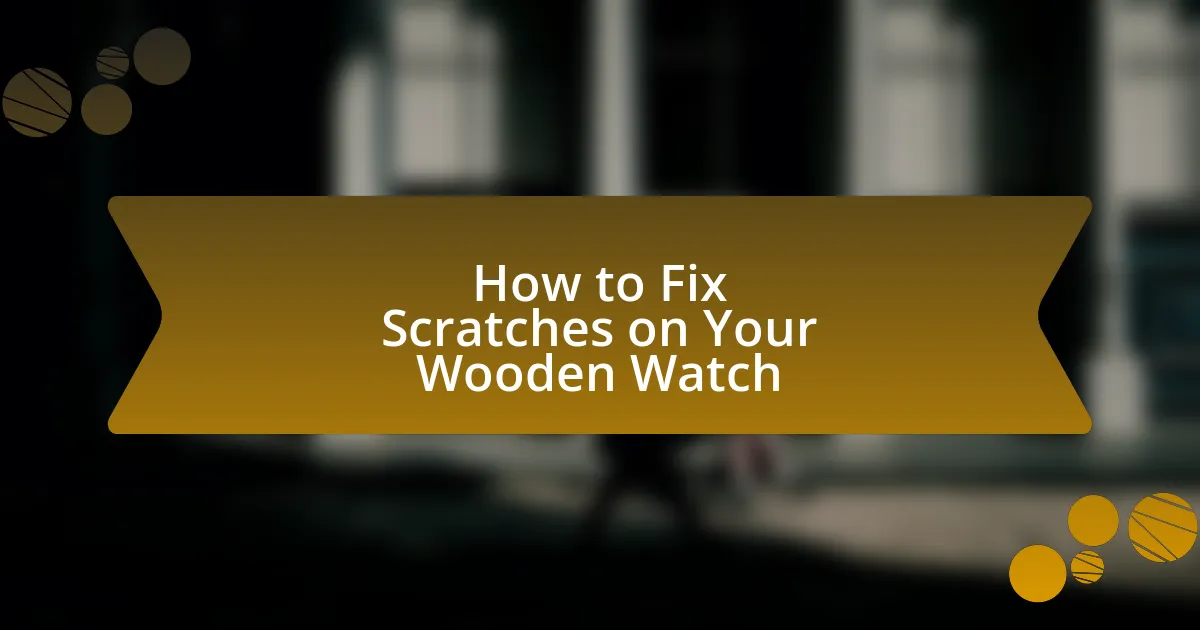The article focuses on how to fix scratches on wooden watches, detailing common causes of scratches such as contact with hard surfaces, exposure to abrasive materials, and environmental factors like humidity and sunlight. It outlines the types of scratches that can occur, methods for assessing their severity, and effective repair techniques, including the use of natural oils and sanding. Additionally, the article emphasizes the importance of proper maintenance and storage solutions to prevent future scratches, as well as the benefits of professional restoration services for more extensive damage.

What are the common causes of scratches on wooden watches?
Common causes of scratches on wooden watches include contact with hard surfaces, exposure to abrasive materials, and improper storage. When wooden watches come into contact with metal objects, concrete, or other hard surfaces, they can easily sustain scratches. Additionally, exposure to sand, dirt, or other abrasive materials can lead to surface damage. Lastly, storing wooden watches in environments where they are likely to rub against other items can also contribute to scratching. These factors highlight the importance of careful handling and storage to maintain the appearance of wooden watches.
How do environmental factors contribute to scratches on wooden watches?
Environmental factors contribute to scratches on wooden watches primarily through exposure to abrasive materials and varying humidity levels. When wooden watches come into contact with rough surfaces, such as concrete or metal, the friction can lead to visible scratches. Additionally, changes in humidity can cause the wood to expand and contract, making it more susceptible to damage from impacts or abrasives. Studies indicate that wood’s natural properties, including its grain and finish, can be compromised by environmental conditions, leading to increased vulnerability to scratches.
What role does humidity play in the maintenance of wooden watches?
Humidity plays a critical role in the maintenance of wooden watches by influencing their structural integrity and appearance. High humidity can cause wood to swell, leading to warping or cracking, while low humidity can result in drying and shrinking, which may create gaps or weaken the watch’s components. Maintaining a stable humidity level between 40% and 60% is essential for preserving the watch’s condition, as fluctuations outside this range can adversely affect the wood’s natural properties. This information is supported by studies on wood preservation, which indicate that consistent humidity levels help prevent damage and prolong the lifespan of wooden items.
How can exposure to sunlight affect the surface of wooden watches?
Exposure to sunlight can cause the surface of wooden watches to fade and discolor over time. The ultraviolet (UV) rays in sunlight break down the lignin in wood, leading to a loss of color and a dull appearance. This degradation can also weaken the wood’s structure, making it more susceptible to scratches and damage. Studies have shown that prolonged exposure to UV light can significantly alter the color and integrity of various wood types, confirming that wooden watches are vulnerable to these effects.
What types of activities lead to scratches on wooden watches?
Activities that lead to scratches on wooden watches include contact with hard surfaces, exposure to abrasive materials, and engaging in sports or physical activities. When wooden watches come into contact with items like metal objects, concrete, or rough fabrics, the likelihood of scratches increases. Additionally, activities such as playing sports, gardening, or any task that involves manual labor can result in unintentional impacts that mar the surface of the watch. These interactions create friction and pressure that can easily scratch the wood, compromising its aesthetic and structural integrity.
How does daily wear and tear impact the finish of wooden watches?
Daily wear and tear significantly impacts the finish of wooden watches by causing scratches, dents, and fading. The natural materials used in wooden watches are susceptible to damage from everyday activities, such as exposure to moisture, sunlight, and physical contact with hard surfaces. Over time, these factors can lead to a dull appearance and loss of luster in the wood finish. For instance, studies show that prolonged exposure to UV light can degrade the finish, while abrasive contact can create visible scratches that compromise the aesthetic appeal of the watch.
What precautions can be taken during physical activities to prevent scratches?
To prevent scratches during physical activities, individuals should wear protective gear such as padded clothing, gloves, and wrist guards. These items create a barrier between the skin and potential sources of scratches, significantly reducing the risk of injury. Additionally, avoiding rough surfaces and being mindful of surroundings can further minimize exposure to sharp objects. Studies indicate that protective gear can reduce injury rates by up to 50% in contact sports, highlighting its effectiveness in safeguarding against scratches.

How can you assess the severity of scratches on your wooden watch?
To assess the severity of scratches on your wooden watch, visually inspect the scratches under good lighting. Minor scratches are usually superficial and can be felt with a fingernail but do not penetrate deeply into the wood. Moderate scratches may be more noticeable, affecting the finish but not compromising the structural integrity of the wood. Severe scratches penetrate deeply, potentially exposing the raw wood and affecting the watch’s durability. Using a magnifying glass can help in identifying the depth and extent of the scratches, allowing for a more accurate assessment.
What are the different types of scratches that can occur on wooden watches?
The different types of scratches that can occur on wooden watches include surface scratches, deep scratches, and gouges. Surface scratches are minor abrasions that affect only the outer layer of the wood, often caused by everyday wear and contact with hard surfaces. Deep scratches penetrate further into the wood, potentially damaging the finish and requiring more extensive repair. Gouges are significant indentations that remove a portion of the wood, often resulting from impacts or sharp objects. Each type of scratch varies in severity and repair needs, with surface scratches typically being the easiest to fix, while gouges may require professional restoration.
How can you differentiate between superficial and deep scratches?
Superficial scratches are shallow marks that affect only the surface finish of the wood, while deep scratches penetrate into the wood fibers, causing more significant damage. To differentiate, examine the depth of the scratch: superficial scratches can often be felt with a fingernail but do not catch on it, whereas deep scratches will catch and may expose raw wood beneath the finish. Additionally, superficial scratches can often be repaired with polishing or refinishing, while deep scratches may require sanding and refinishing to restore the wood’s appearance.
What tools can help in evaluating the depth of scratches?
Calipers and micrometers are effective tools for evaluating the depth of scratches. Calipers can measure the depth of a scratch by providing precise readings, while micrometers offer even greater accuracy for finer scratches. Both tools are commonly used in various industries for measuring small distances and can provide reliable data on scratch depth, ensuring that repairs can be accurately assessed and executed.
Why is it important to assess scratches before attempting repairs?
Assessing scratches before attempting repairs is crucial to determine the appropriate repair method and avoid further damage. Different types of scratches may require specific techniques; for instance, superficial scratches can often be polished out, while deeper ones may necessitate sanding or refinishing. Understanding the depth and nature of the scratch ensures that the repair process is effective and preserves the integrity of the wooden watch. Additionally, improper assessment can lead to inadequate repairs, resulting in a less appealing appearance or even compromising the watch’s structure.
How can improper assessment lead to further damage?
Improper assessment can lead to further damage by causing incorrect treatment of scratches on a wooden watch. When the severity of the scratch is misjudged, inappropriate methods or materials may be used, such as harsh chemicals or abrasive tools, which can worsen the damage or affect the wood’s finish. For instance, a study by the American Wood Council indicates that using the wrong sanding technique can lead to deeper scratches or uneven surfaces, ultimately compromising the integrity and aesthetic of the watch.
What are the potential risks of DIY repairs on wooden watches?
The potential risks of DIY repairs on wooden watches include damaging the watch’s delicate components, compromising its waterproofing, and affecting its aesthetic appeal. Wooden watches often contain intricate mechanisms that require specialized tools and knowledge for proper handling; improper repairs can lead to misalignment or breakage of these parts. Additionally, using inappropriate cleaning agents or techniques can strip the wood of its finish, leading to discoloration or deterioration. Lastly, DIY repairs may void any existing warranties, leaving the owner responsible for future repairs or replacements.

What are the best methods to fix scratches on wooden watches?
The best methods to fix scratches on wooden watches include using a wood polish or wax, applying a mixture of olive oil and vinegar, and utilizing fine sandpaper for deeper scratches. Wood polish or wax can restore the finish and conceal minor scratches effectively, while a mixture of olive oil and vinegar can enhance the wood’s natural luster and fill in small imperfections. For deeper scratches, fine sandpaper can be gently used to sand down the area, followed by reapplying a wood finish to match the surrounding surface. These methods are commonly recommended by watch care experts and are effective in maintaining the aesthetic quality of wooden watches.
How can you use natural oils to repair minor scratches?
Natural oils can be used to repair minor scratches on wooden watches by applying a small amount of oil, such as olive oil or coconut oil, directly onto the scratched area. The oil penetrates the wood, helping to fill in the scratch and restore the wood’s natural luster. For effective results, gently rub the oil into the scratch using a soft cloth in a circular motion, allowing it to absorb for a few minutes before wiping off any excess. This method is supported by the fact that natural oils contain fatty acids that nourish and protect wood, enhancing its appearance and longevity.
What types of oils are most effective for wooden watch restoration?
The most effective oils for wooden watch restoration are tung oil, linseed oil, and mineral oil. Tung oil penetrates deeply into the wood, providing a durable finish that enhances the natural grain and protects against moisture. Linseed oil, particularly boiled linseed oil, offers a rich luster and is known for its ability to nourish and protect wood surfaces. Mineral oil is a non-drying oil that is safe for food contact, making it suitable for watches that may come into contact with skin. These oils not only restore the appearance of wooden watches but also help in preventing further damage by creating a protective barrier.
How do you apply oil to minimize the appearance of scratches?
To minimize the appearance of scratches on a wooden watch, apply a small amount of mineral oil or furniture oil directly onto a soft cloth. Gently rub the oil into the scratched area in a circular motion, allowing it to penetrate the wood. This process helps to fill in the scratches and restore the wood’s natural luster. The effectiveness of this method is supported by the fact that oils can enhance the wood’s appearance by providing moisture and reducing the visibility of imperfections.
What sanding techniques can be used for deeper scratches?
To address deeper scratches on a wooden watch, the most effective sanding techniques include using progressively finer grits of sandpaper, starting with a coarse grit (around 80-120) to remove the scratch, followed by medium grit (around 220) to smooth the area, and finishing with a fine grit (around 400-600) for a polished surface. This method ensures that the scratch is effectively diminished while maintaining the integrity of the wood. The use of finer grits helps to blend the repaired area with the surrounding wood, resulting in a seamless finish.
How do you choose the right sandpaper grit for wooden watches?
To choose the right sandpaper grit for wooden watches, start with a coarse grit, such as 80 to 120, to remove deep scratches and imperfections. Following this, progress to medium grits like 150 to 220 for smoothing the surface, and finish with fine grits, such as 320 to 400, to achieve a polished and refined finish. This method ensures that the wood is properly prepared and maintains its aesthetic quality, as using the appropriate grit sequence prevents damage and enhances the overall appearance of the watch.
What steps should you follow to sand down scratches safely?
To sand down scratches safely on a wooden watch, first, gather the necessary materials, including fine-grit sandpaper (around 400 to 600 grit), a soft cloth, and wood finish or oil. Begin by cleaning the scratched area to remove any dirt or debris, ensuring a smooth sanding process. Next, gently sand the scratched area in the direction of the wood grain using light pressure to avoid damaging the surrounding wood. After sanding, wipe away any dust with a soft cloth. Finally, apply a wood finish or oil to restore the luster and protect the wood, ensuring the repair blends seamlessly with the rest of the watch.
What are the benefits of professional restoration services for wooden watches?
Professional restoration services for wooden watches provide several key benefits, including expert craftsmanship, preservation of value, and enhanced longevity. These services utilize specialized techniques and materials tailored for wooden components, ensuring that repairs maintain the watch’s original aesthetic and structural integrity. For instance, professional restorers can effectively remove scratches and restore the finish without damaging the wood, which is crucial for maintaining the watch’s market value. Additionally, these services often include thorough cleaning and conditioning, which can prevent future damage and extend the life of the watch.
How can you find a reputable watch restoration service?
To find a reputable watch restoration service, research online reviews and ratings on platforms like Google, Yelp, or specialized watch forums. These platforms provide user experiences and feedback, which can help identify trustworthy services. Additionally, check for certifications or affiliations with recognized watchmaking organizations, as these credentials often indicate a higher level of expertise and professionalism in watch restoration.
What should you expect in terms of cost and time for professional repairs?
For professional repairs of scratches on a wooden watch, you should expect costs ranging from $50 to $150, depending on the severity of the damage and the repair service used. The time required for these repairs typically spans from one to two weeks, as it involves careful refinishing and drying processes. This cost range is supported by industry standards for watch repairs, where minor refinishing is generally priced lower, while extensive restoration may incur higher fees. The timeframe reflects the meticulous nature of working with wood, which requires precision and care to maintain the watch’s integrity.
What are some tips for maintaining your wooden watch to prevent future scratches?
To maintain your wooden watch and prevent future scratches, regularly clean it with a soft, lint-free cloth to remove dust and debris. This practice helps minimize the risk of scratches caused by particles that can scratch the wood surface. Additionally, applying a wood conditioner or oil specifically designed for wooden watches every few months can enhance the wood’s protective layer, making it more resistant to scratches. Storing the watch in a dedicated case or pouch when not in use further protects it from potential impacts and scratches. These methods are effective as they address both surface maintenance and protective storage, ensuring the longevity of the wooden watch.
How can regular cleaning help preserve the finish of your wooden watch?
Regular cleaning helps preserve the finish of your wooden watch by removing dirt, oils, and moisture that can degrade the wood’s surface. When these contaminants accumulate, they can lead to discoloration and damage, compromising the protective finish. Regular maintenance, such as using a soft cloth to wipe the watch, prevents buildup and maintains the integrity of the finish, ensuring that the wood remains vibrant and protected from scratches and wear.
What storage solutions can protect your wooden watch from scratches?
To protect your wooden watch from scratches, use a soft-lined watch box or a padded watch roll. These storage solutions provide cushioning that minimizes the risk of scratches during storage. Soft materials, such as velvet or microfiber, prevent direct contact with hard surfaces, which can cause damage. Additionally, keeping the watch in a dedicated compartment within the box or roll further reduces movement and potential friction, ensuring the watch remains in pristine condition.
